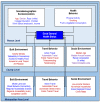Health Impacts of the Built and Social Environments, and Travel Behavior: The Case of the Sunshine State
- PMID: 35897467
- PMCID: PMC9329847
- DOI: 10.3390/ijerph19159102
Health Impacts of the Built and Social Environments, and Travel Behavior: The Case of the Sunshine State
Abstract
As physical inactivity statistics for the U.S. population show an alarming trend, many health problems have been increasing among Americans in recent decades. Thus, identification of the factors that influence people's physical activity levels and health outcomes has become ever more essential to promote public health. The built envSFironment is among the main factors that impact individuals' health outcomes. However, little is known about the health impacts of built environment factors at large geographical scales such as those of the metropolitan area of residence. Further, the health impacts of travel behavior such as telecommuting and teleshopping remain unclear. This study uses an ecological model framework to probe the roles of travel behavior and built as well as social environments at different spatial levels in health. Instrumental variable binary probit models have been developed to examine the complex interlinks between measures of travel behavior, physical activity levels, built and social environment characteristics, and individuals' health outcomes. Findings indicate that built and social environment factors at different spatial levels, including the metropolitan area, are correlated with individuals' health outcomes. Additionally, the findings suggest that increased levels of telecommuting and teleshopping within communities may lead to unfavorable health outcomes. The findings shed light on the most promising policy interventions that can promote public health through modifications targeting people's travel choices as well as the built and social environments within urban areas.
Keywords: active travel; bicycling; built environment; ecological model; health; socioeconomic factors; telecommuting; teleshopping; urban form; walking.
Conflict of interest statement
The authors declare no conflict of interest.
Figures





Similar articles
-
The impact of interventions in the built environment on physical activity levels: a systematic umbrella review.Int J Behav Nutr Phys Act. 2022 Dec 20;19(1):156. doi: 10.1186/s12966-022-01399-6. Int J Behav Nutr Phys Act. 2022. PMID: 36550583 Free PMC article.
-
Examining the Nonlinear Effects of Residential and Workplace-built Environments on Active Travel in Short-Distance: A Random Forest Approach.Int J Environ Res Public Health. 2023 Jan 20;20(3):1969. doi: 10.3390/ijerph20031969. Int J Environ Res Public Health. 2023. PMID: 36767336 Free PMC article.
-
How the built environment affects physical activity: views from urban planning.Am J Prev Med. 2002 Aug;23(2 Suppl):64-73. doi: 10.1016/s0749-3797(02)00475-0. Am J Prev Med. 2002. PMID: 12133739
-
Examining the association between the built environment and active travel using GPS data: A study of a large residential area (Daju) in Shanghai.Health Place. 2023 Jan;79:102971. doi: 10.1016/j.healthplace.2023.102971. Epub 2023 Jan 20. Health Place. 2023. PMID: 36682263
-
Built Environment Interventions to Increase Active Travel: a Critical Review and Discussion.Curr Environ Health Rep. 2019 Dec;6(4):309-315. doi: 10.1007/s40572-019-00254-4. Curr Environ Health Rep. 2019. PMID: 31773498 Free PMC article. Review.
Cited by
-
What might working from home mean for the geography of work and commuting in the Greater Golden Horseshoe, Canada?Urban Stud. 2024 Feb;61(3):567-588. doi: 10.1177/00420980231186499. Epub 2023 Aug 7. Urban Stud. 2024. PMID: 38313681 Free PMC article.
References
-
- Physical Activity Guidelines for Americans, 2nd Edition. [(accessed on 6 May 2022)]; Available online: https://health.gov/paguidelines/second-edition/pdf/Physical_Activity_Gui....
-
- National Center for Health Statistics Health, United States, 2019: Table 025. [(accessed on 6 May 2022)]; Available online: https://www.cdc.gov/nchs/hus/contents2019.htm.
-
- National Center for Health Statistics Health, United States, 2019: Table 014. [(accessed on 6 May 2022)]; Available online: https://www.cdc.gov/nchs/hus/contents2019.htm.
-
- National Center for Health Statistics Health, United States, 2019: Table 022. [(accessed on 6 May 2022)]; Available online: https://www.cdc.gov/nchs/hus/contents2019.htm.
-
- National Center for Health Statistics Health, United States, 2019: Table 026. [(accessed on 6 May 2022)]; Available online: https://www.cdc.gov/nchs/hus/contents2019.htm.
MeSH terms
LinkOut - more resources
Full Text Sources
Medical
Research Materials

